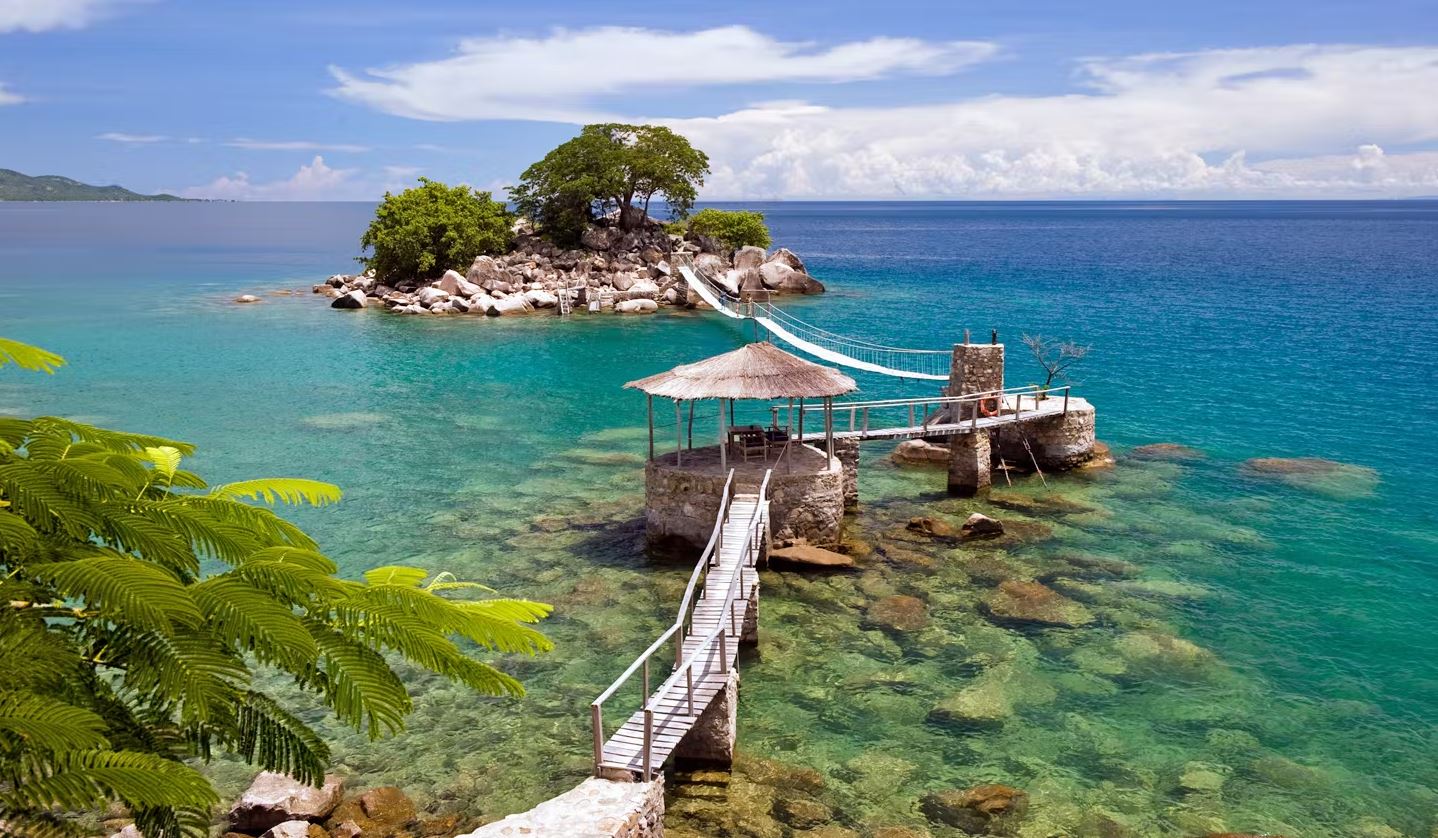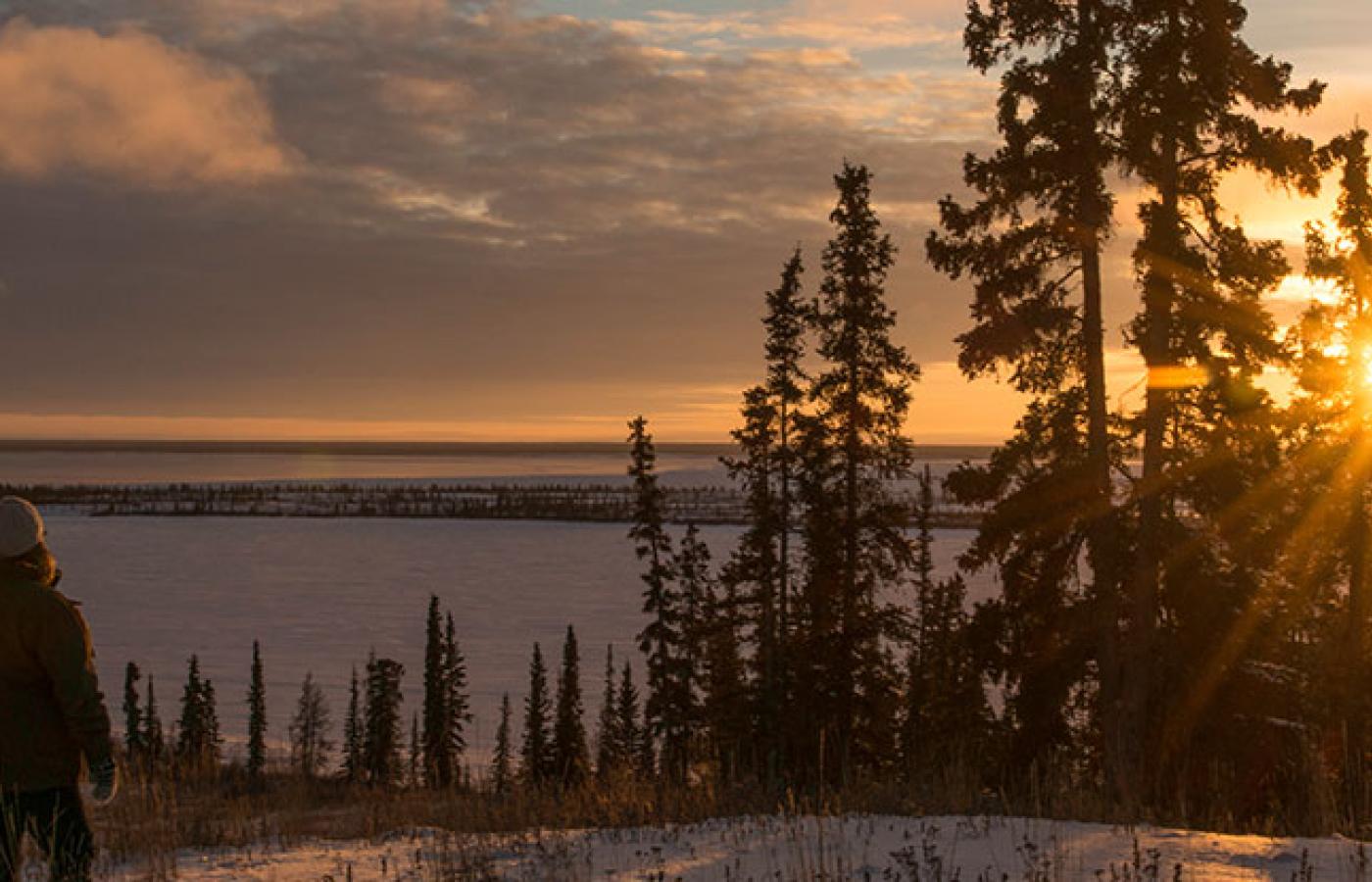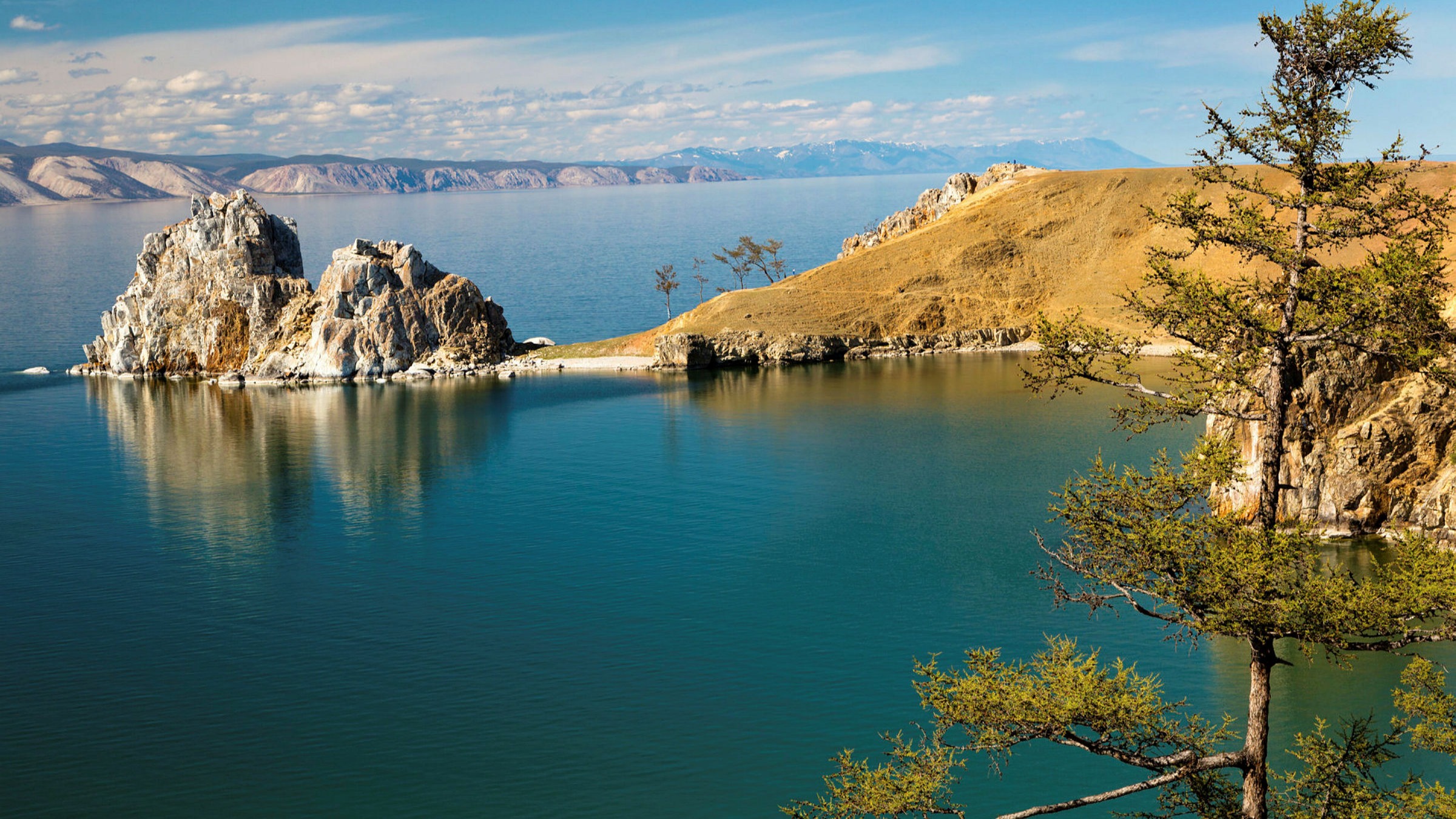Lakes are bodies of water surrounded by land and one or more rivers that fill and empty the lake. There are no oceans that are directly connected to lakes. Their water is likewise not flowing like rivers. Despite the fact that there isn’t a universally recognized distinction between lakes and ponds, lakes are typically thought to have water bodies that are at least 10 hectares in size (25 acres). Ponds are smaller bodies of water. The majority of lakes on Earth are natural bodies of water, but there are also man-made, artificial lakes. But all of the largest lakes on earth are created naturally. The top ten largest lakes in the world are included in the table below.
10. GREAT SLAVE LAKE

- Lake Size: ~ 27,000 km²
- Maximum Depth: ~ 614 m
- Length: ~ 480 km
- Shoreline Location: Canada
The vast freshwater lake known as Great Slave Lake is situated in Canada’s Northwest Territories. At a maximum depth of 614 meters, it is the deepest lake in North America and the second-largest lake fully within Canada. There are roughly 28,930 square kilometers of the lake on the planet. The waters of Great Slave Lake are renowned for their clarity and are home to a wide variety of fish species, such as lake trout, northern pike, and Arctic grayling. The lake is an important supply of fresh water and a key route for transportation in the area. For their livelihoods, including fishing and hunting, the local Dene people have depended on the lake’s resources for thousands of years.
Due to the availability of options for boating, fishing, and other leisure activities, Great Slave Lake is also a well-liked holiday spot for outdoor enthusiasts. Many animals, including wolves, grizzly bears, and black bears, call the lake and its surroundings home. Ospreys, bald eagles, and pelicans are among the numerous birds that frequent the lake. The lake’s delicate environment and distinctive biodiversity are being protected, and measures are being taken to do so, such as preserving its fish populations and reducing pollution in the region. The creation of national parks and other protected areas has also aided in preserving the natural beauty of the lake and fostering ecotourism.
9. Lake Malawi

- Lake Size: ~ 29,500 km²
- Maximum Depth: ~ 706 m
- Length: ~ 579 km
- Shoreline Location: Tanzania, Malawi, Mozambique
Southeast Africa’s Lake Malawi, also called Lake Nyasa, is a sizable freshwater lake that is bordered by Tanzania, Mozambique, and Malawi. With a surface size of over 29,600 square kilometers, it is the third-largest lake in Africa and the ninth-largest lake among the top ten largest lakes in the world by volume. Almost 1,000 kinds of fish, the majority of which are unique to Lake Malawi, are among the aquatic life that makes the body of water famous for its clean waters and diverse aquatic life. Among aquarium hobbyists, the lake is well-known for its vividly colored cichlid fish. The lake supports a variety of flora and wildlife and is a significant source of freshwater for the area. With fishing being a major sector, it is also a vital economic resource for the nearby communities.
Many small fishing communities may be found around the lake, and UNESCO has acknowledged the people’s traditional fishing techniques as an example of intangible cultural heritage. With options for swimming, snorkeling, and other water sports, Lake Malawi is another well-liked tourist attraction. A variety of animals, including elephants, lions, and leopards, can be found in the vicinity’s national parks and reserves. The lake’s delicate environment and distinctive biodiversity are being protected, and measures are being taken to do so, such as preserving its fish populations and reducing pollution in the region.
8. Great Bear Lake

- Lake Size: ~ 31,000 km²
- Maximum Depth: ~ 446 m
- Length: ~ 373 km
- Shoreline Location: Canada
The vast freshwater lake known as Great Bear Lake is situated in Canada’s Northwest Territories. It is the largest lake entirely within Canada and the fourth largest lake in all of North America. The lake’s maximum depth is 446 meters, and its surface size is roughly 31,000 square kilometers. The waters of Big Bear Lake are renowned for their clarity and are home to a wide variety of fish species, such as lake trout, arctic grayling, and whitefish. The lake’s name comes from the fact that it is home to a sizable population of grizzly bears.
The lake provides a significant amount of freshwater and acts as a key thoroughfare for the area. For their livelihoods, including fishing and hunting, the local Dene people have depended on the lake’s resources for thousands of years. With chances for boating, fishing, and other outdoor entertainment, Great Bear Lake is a well-liked holiday spot for nature lovers. The lake’s delicate environment and distinctive biodiversity are being protected, and measures are being taken to do so, such as preserving its fish populations and reducing pollution in the region.
7. Lake Baikal

- Lake Size: ~ 31,500 km²
- Maximum Depth: ~ 1,642 m
- Length: ~ 636 km
- Shoreline Location: Russia
Russia’s Siberia is home to the enormous freshwater lake known as Lake Baikal. With 20% of the globe’s freshwater that isn’t frozen in it, it is the largest freshwater lake by volume among the top ten largest lakes in the world. The lake has a maximum depth of 1,642 meters, is around 636 kilometers long, and can be up to 80 kilometers broad. The waters of Lake Baikal are renowned for being among the purest in the world and for their distinctive biodiversity. More than 3,000 different plant and animal species, including the unique Baikal seal, can be found around the lake. Moreover, it is a UNESCO World Historic Site.
The water in the lake is remarkably clear and clean, with visibility frequently exceeding 40 meters. In addition, the water is quite chilly, with an average temperature of only 39°F (4°C). The lake frequently freezes over in the winter, generating a thick coating of ice that can be several feet thick, making it a well-liked location for winter sports like ice skating and ice fishing. The lake provides the area with a significant amount of freshwater, and it also acts as a crucial conduit for the movement of goods like oil and timber. Unfortunately, the delicate ecosystem of the lake is starting to be impacted by human activities, particularly industrial pollution, and development, and measures are being taken to conserve it.
6. Lake Tanganyika

- Lake Size: ~ 32,600 km²
- Maximum Depth: ~ 1,470 m
- Length: ~ 676 km
- Shoreline Location: Democratic Republic of the Congo, Zambia, Tanzania, Burundi
East Africa’s Lake Tanganyika is a sizable freshwater lake that is bordered by Tanzania, Congo, Burundi, and Zambia. About 676 kilometers long and up to 72 kilometers wide, it is the second-deepest lake in the world and the longest freshwater lake. The lake is the second-largest freshwater lake by volume in the world with a maximum depth of 1,470 meters and a total volume of 18,880 cubic kilometers.
It is renowned for its beautiful waters and abundant aquatic life, which includes more than 350 fish species that are unique to this planet. Fishing is a prominent economic activity around Lake Tanganyika, which is a substantial source of income for the locals. Also, it provides the area with essential water resources and is home to a variety of plants and animals, such as chimpanzees, elephants, and hippos. Researchers, scientists, and tourists all like visiting the lake because of its distinctive features and biodiversity.
5. Lake Michigan

- Lake Size: ~ 58,000 km²
- Maximum Depth: ~ 281 m
- Length: ~ 494 km
- Shoreline Location: United States
The only Great Lake that is totally contained inside the United States is Lake Michigan, which is the third-largest Great Lake in North America and the fifth-largest freshwater lake among the top ten largest lakes in the world by volume. Lake Michigan is the largest lake in the world that is contained entirely within a single nation. The states of Michigan, Wisconsin, Illinois, and Indiana form the borders of Lake Michigan, which is joined to Lake Huron by the Straits of Mackinac. The lake’s maximum depth is 281 meters, and its surface size is roughly 58,000 square kilometers.
It is well-known for its crystal-clear waters, sandy beaches, and a variety of fish species, including trout, salmon, and bass. Cities and towns along the Lake Michigan shoreline include Chicago, Milwaukee, Grand Rapids, and Green Bay. For boating, fishing, swimming, and other leisure pursuits, it is a well-liked holiday spot. The lake is crucial for transportation since it carries products like grain, coal, and iron ore. Around the lake’s shores dwell more than 12 million people or about 4% of the country’s population.
4. Lake Huron

- Lake Size: ~ 59,600 km²
- Maximum Depth: ~ 229 m
- Length: ~ 332 km
- Shoreline Location: United States, Canada
One of the top ten largest lakes in the world, Lake Huron is situated between the US and Canada. It has the name of the Huron, a Canadian indigenous group that has long resided between Lake Huron and Lake Ontario. With a surface area of over 59,600 square kilometers, it is the third-largest freshwater lake in the world. The Straits of Mackinac connect Lake Huron to Lake Michigan, and the Great Lakes Waterway connects Lake Huron to Lake St. Clair and the St. Lawrence River. The lake is a well-liked location for boating and leisure activities because it is home to approximately 30,000 islands.
Water from the lake is a valuable natural resource for the area because it may be used for irrigation, drinking, and industrial purposes. It also supports a wide range of plant and animal life, including lake trout and whitefish, two fish used for commercial purposes. With large forests, mineral deposits, and agricultural fields, the region around Lake Huron is also abundant in natural resources. Lake Huron is a significant body of water, but it also faces environmental issues like pollution, invasive species, and climate change. To address these issues, efforts are being made to limit pollution and the spread of non-native species, as well as to encourage sustainable land use and conservation methods.
3. Lake Victoria

- Lake Size: ~ 68,870 km²
- Maximum Depth: ~ 81 m
- Length: ~ 322 km
- Shoreline Location: Kenya, Tanzania, Uganda
With a surface area of over 68,870 square kilometers, Lake Victoria is the largest lake in Africa and the second-largest freshwater lake in the world. Three nations—Tanzania, Uganda, and Kenya—share this region of East Africa. The lake was formerly referred to by the locals as “Ukerewe” before being given the name Queen Victoria, the British monarch. With its ability to supply water for farming, hydroelectric power generation, and fishing, Lake Victoria is a crucial resource for the area. More than 500 different fish species may be found in the lake, including the important commercial fish species known as the Nile perch.
The principal river entering the lake is the Kagera River. The lake, however, also has to contend with a number of environmental issues, such as pollution, overfishing, and the introduction of non-native species. A number of initiatives have been taken in recent years to address these issues, such as the creation of protected areas and the promotion of sustainable fishing methods. Notwithstanding these difficulties, Lake Victoria continues to be a significant natural and cultural monument in East Africa, luring travelers from all over the world with its breathtaking scenery and illustrious cultural past.
2. Lake Superior

- Lake Size: ~ 82,100 km²
- Maximum Depth: ~ 406 m
- Length: ~ 616 km
- Shoreline Location: United States, Canada
One of the five Great Lakes in North America, Lake Superior has the biggest surface area of any freshwater lake in the world. It is second among the top ten largest lakes in the world. It is situated on the border between the United States and Canada, with most of the lake being under American control. Minnesota, Wisconsin, and Michigan are three states in the United States that border Lake Superior. Millions of people have access to drinking water, hydroelectric electricity, and recreational activities thanks to the lake, which is a significant natural resource for the area.
The maximum depth of Lake Superior is 406 meters, and its surface area is roughly 82,100 square kilometers. With an average temperature of around 40°F (4°C) and a visibility range of up to 8 meters, it is also one of the Great Lakes that is coldest and clearest. It also sustains a wide range of plant and animal life, including lake trout and whitefish, two commercial fish species. The Apostle Islands and the Pictured Rocks National Lakeshore are just two examples of the breathtaking natural landscape that surrounds Lake Superior.
1. Caspian Sea

- Lake Size: ~ 371,000 km²
- Maximum Depth: ~ 1,025 m
- Length: ~ 1,199 km
- Shoreline Location: Turkmenistan, Kazakhstan, Russia, Azerbaijan & Iran
The largest lake on Earth is without a doubt the Caspian Sea. Due to its magnitude, the Caspian Sea is frequently referred to as a “sea” rather than a “lake,” but there is disagreement over this designation. Because it is landlocked and has no direct access to the ocean, some people think of it as a lake, while others think of it as a sea due to its vastness and the salinity of its water. Iran to the south, Turkmenistan to the southeast, Russia to the north, Kazakhstan to the northeast, and Azerbaijan to the west are its neighbors.
The Caspian Sea, with a surface size of over 371,000 square kilometers and a maximum depth of 1,025 meters, is in fact the world’s biggest enclosed body of water. Its waters are also only mildly salinized, with salinities ranging from 1.2% to 1.6%, which is less than the 3.5% salinity of the typical ocean. More than 130 endemic plant and animal species that can only be found in the waters of the Caspian Sea make up its distinctive ecology. With huge reserves under the seabed, it is also a significant supplier of oil and natural gas.
Above we discussed the top ten largest lakes in the world. The world’s largest lakes are dispersed all over the place. But North America is home to many of the largest lakes. These lakes have enormous volumes, lengths, depths, and surface areas. Many of these lakes have shorelines that are shared by several nations. Several of these lakes, like Lake Michigan, are rather sizable and are found only in one nation.














